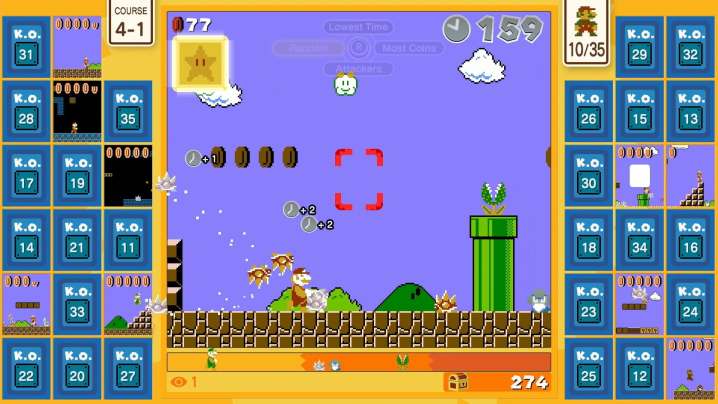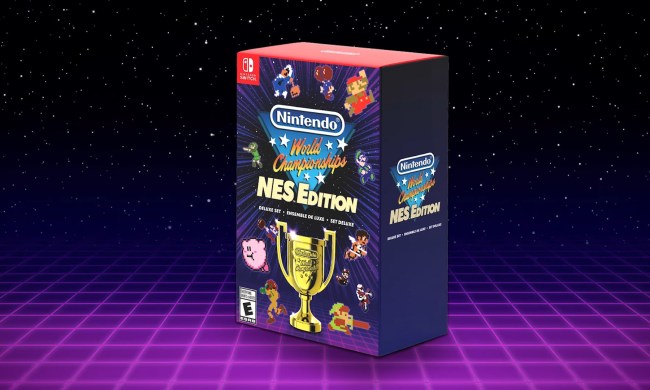Super Mario Bros. 35 is out now, adding a battle royale twist to the original Super Mario Bros. On paper, it sounds simple enough. You race through Mario stages and try to outlive 34 other players. Unfortunately, the game is far more complicated than it seems, and there’s no tutorial in sight.
If you’re completely lost about mechanics like targeting, coins, or even how to win, here’s everything the game doesn’t tell you. You’ll have your first win in no time.

The basics
Super Mario Bros. 35 is a survival game, where you play a gauntlet of Mario stages and try not to die. If you manage to stay alive longer than everyone else you’ve been matched with, you’ll win. On the flip side, if you die by any hazard or time out, you’re eliminated entirely. You’ll often see opponents get wiped out within seconds as they run into the first Goomba—it’s that unforgiving.
There are two modes: 35-player Battle and Special Battle. The former is your standard round, while the special mode starts every player with the same item and gives them the same sequence of stages.
There’s also a stats tab where you can view your records, and a practice mode where you can free play any stage you’ve unlocked.
Time management
Time is the most important piece of this Mario game, as much of what you’re actually doing is managing the clock. Every time you kill an enemy or clear a stage, you’ll get some precious time back, which helps ensure that you don’t lose to the clock.
Enemies award different time bonuses depending on how you defeat them. For example, if you stomp on a Koopa, you’ll get three seconds back, but if you kill one via fire flower, you’ll get one second. Successfully killing bigger enemies like Bowser can net you up to ten seconds.
Likewise, jumping to the top of a flagpole will net you 15 seconds, while grabbing the bottom only gets you three. You’ll also get 15 seconds back if you grab a power-up that you already have. So if you have fire power and find a flower, you can grab it for a big boost.
As you get down to the final five, the clock will tick down much faster, making every second crucial. Winning involves a balance of precise platforming and quick thinking to avoid a time out.
Loadouts
When you first start a game, you’ll go to a screen that lets you create a sort of loadout. You can pick an item to start with and a stage.
The item part is simple enough. Whenever you finish a round, you’ll get some coins for things like knocking out opponents. Those coins can be spent to give you a starting item. You can begin the game with a mushroom, fire flower, or star if you have enough coins. Press X on the screen to cycle between them.
The fire flower is a bit of a no-brainer, as it lets you safely take out enemies from a distance. That’s especially helpful when your screen starts filling up with foes. You’ll usually get plenty of coins in a game, so you’ll rarely be strapped for cash, so make sure to set a flower for an advantage.

Stages are a little more confusing. Essentially, you can pick any stage from the original Super Mario Bros. game and add it to the pool of stages that’ll show up during the game. So, if you want to make the game more challenging, you can throw in a stage like 8-4 to make the game harder for everyone. Just make sure you’re picking stages you can actually clear yourself.
When you start, you’ll only have stage 1-1 unlocked. Every time you clear a stage, you’ll unlock another one. If you beat a stage you don’t currently have during a game, you’ll unlock it that way as well. Because of this, you’re bound to play levels from the first world a lot, as new players don’t have a lot of options.
Sending enemies
The main way you interact with your opponents is by sending more enemies to their game. Every time you defeat an enemy, you’ll send it over to another player’s game.
As you play, you’ll see grayed-out enemies appearing on screen. That color palette indicates that it was sent over by another player. As the game goes on and you play more stages, you’ll find enemies like Bloopers, Hammer Brothers, or even Bowser himself showing up where they don’t usually belong.
Targeting players
You can choose who you send enemies to in a few ways. You can manually select any player in the game by using the left control stick to highlight their screen.
The main way you target is through a system similar to that in Tetris 99. By using the right stick, you can choose to pick on certain types of players. By default, you’re set to just attack random players.
Pressing up on the stick selects the player who has the lowest time remaining on their clock, the right option goes after the player with the most coins, and down targets any player currently attacking you.
This can be a blessing or a curse, so you’ll need to choose wisely. For example, if you target someone who doesn’t have much time left, you’re essentially giving them more enemies to defeat, which could help them regain time instead of overwhelm them. Setting your target to Random or Attackers can often be more helpful than trying to hinder the bottom or top players.
What coins do
The coins Mario collects in the game (as opposed to the ones you, the player, get from KO’ing opponents) serve a specific function. Every time you collect 20, you can spend them on an Item Roulette. When you press the X button, you’ll get a random item right away.
You’ll either receive a mushroom, fire flower, invincibility star, or POW block. The latter clears every enemy on screen and gives you time for each one, so it can be very helpful if the clock is counting down.
There’s no limit to how many coins you can hold, so you can bank over a hundred and spend them later when you’re in a tight spot. It’s especially helpful to hold on to a bunch so you can try to get a fire flower back if you lose it.

Challenges and unlockables
There are a few things for players to do other than win. For one, every match will net you experience points. As you level up, you’ll unlock new player badges that you can display in the game. You can access these by pressing X on the main menu.
Players have daily challenges that they can complete to get coins, such as defeating a certain number of enemies or using the Item Roulette function in battle. Press down on the right stick on the main menu to see the checklist.
When you finally nab first place, you’ll unlock Coin Ranking, which are essentially global leaderboards that show you who has collected the most coins in a game and how your best stacks up. Once you have this function, hover over a game mode and press the plus button to access the leaderboards.



